Beginning in the early 19th century, much of present-day Vietnam was once again unified after being divided by rivaling feudal lords for centuries. The Nguyen dynasty, the last dynasty in the history of Imperial Vietnam, ruled the country for more than one hundred years, a period of time marked by increasingly assertive French colonial might in the region. The palace in Hue witnessed changing tones of successive emperors toward the European power’s influence, from hostility in the early decades of the Nguyen dynasty’s rule to outright subjugation toward its final years. However, regardless of their different stances, all Nguyen emperors made sure their final resting places around the capital were showered in opulence.
Minh Mang
In 1820, Minh Mang, the fourth son of the first emperor of the Nguyen dynasty, ascended the throne at the age of 29. His 21 years of rule saw the reforms of the government administrative structure as well as of land ownership. Under his reign, wealthy individuals were prevented from acquiring land excessively. However, his policies toward ethnic minority groups and foreign powers were described as hostile and xenophobic. Different peoples living in Imperial Vietnam were increasingly sinicized to create a uniformed national identity. A staunch Confucian himself, he imposed strict values of his beliefs upon non-Vietnamese ethnic groups, claiming it would help them leave their “barbarian” cultures behind.
The emperor was no more sympathetic to foreign powers. Not only was he hostile toward the French for the European nation’s colonial agenda as well as the French missionaries who he believed were spreading a perverted and corrupt religion, but he also turned down an offer from Burma to form an alliance to defeat Siam, their common enemy. An effort by the U.S. President Andrew Jackson to establish relations with Vietnam was also met with a lukewarm response. Minh Mang, it seemed, only focused on restructuring his empire from the inside and did not bother to foster ties beyond his realm.
As a traditionalist, the emperor was very concerned about his descendants. Due to the many wives and children he had, Minh Mang created an imperial succession poem which would determine the surnames of his progeny. Many years later, however, this has led to unexpected confusion for a Vietnamese American blogger who wonders about continuing or ending the tradition.
Long after his death, people – both his descendants as well as modern-day visitors – can still see Minh Mang’s vision for Vietnam from his expansive tomb located at a tranquil setting outside Hue. The layout epitomizes many aspects of Chinese tradition which inspired the emperor, with multiple gates, pavilions and temples guarding the long pathway toward the tomb. Surrounded by a crescent pond, the tomb itself sits on a verdant hill locked away from both the outside world and unwanted visitors, just like how Minh Mang ruled his empire.
Tu Duc
Six years after Minh Mang’s death, Tu Duc ascended the throne of Imperial Vietnam. In his relatively long reign, the country continued to witness the oppression of minorities, particularly Catholics. He further ordered Vietnamese Catholic converts to renounce their religion or risk their rights as citizens. Meanwhile, disputes among Confucian scholars over Tu Duc’s legitimacy to rule the empire worsened and rebellions became commonplace, stemmed by dissatisfaction toward the emperor.
In response to Tu Duc’s oppressive policies toward the Catholics as well as exploiting the empire’s fragile unity, the French forced the emperor to cede southern parts of Vietnam, including Saigon, to appease the European power so he could focus on crushing the rebels elsewhere in his dwindling empire. However, amid the emperor’s deteriorating health, the French moved further north and occupied Hanoi. China, seeing this part of Vietnam within its realm of influence, and upon the request of Tu Duc himself, was then involved in an eight-month conflict with the French which ended in victory for the European power. Tu Duc didn’t live long enough to see the aftermath of the conflict, from which France was further emboldened to get deeply involved in Vietnam’s politics. For this reason, Tu Duc is often regarded as Imperial Vietnam’s last independent emperor.
As opposed to Minh Mang’s tomb compound which is spread across a vast landscape in a linear layout, that of Tu Duc’s sits in the middle of a jumble of temples, halls, pavilions and other royal tombs. And unlike that of his predecessor which rests on a hill and is closed from the public, Tu Duc’s tomb – located at the very end of a series of guardian statues and a stele pavilion – is located in a quiet enclosure which is open for everyone to pay a visit.
Khai Dinh
In 1916, more than three decades after Tu Duc’s death, Vietnam’s penultimate emperor came to power. Khai Dinh, the 12th ruler of the Nguyen dynasty, ascended the throne during a period when the French effectively controlled Vietnam. The son of the ninth emperor who was installed by France, Khai Dinh continued his father’s close collaboration with the colonial power. Although assuming the title emperor, his position was merely ceremonial as important decisions regarding the nation were made by the French.
In the early years of Khai Dinh’s reign, the Confucian examination system was suppressed – a dramatic change from what the early emperors of the Nguyen dynasty imposed. A few years later, the emperor issued a decree, adopting the Romanized Vietnamese alphabet in all written discourse. First developed by a Jesuit Portuguese priest, the new alphabet had been further developed by French missionaries from the 17th century onward. What was used to spread Catholicism among the locals eventually became the country’s official writing system in 1919. Wise people say you reap what you sow. What Minh Mang had done to the ethnic minority groups, uprooting them from their cultures, seemed to come around to the same dynasty almost a century later.
Khai Dinh’s unpopularity for his pro-French policies reached its peak two years prior to his death. He allowed the French to levy higher taxes on the Vietnamese people, partly to fund his own opulent tomb. Perched on a slope to the south of the capital, the imposing compound rests on multiple platforms reached by a flight of stairs. Inside the grandest structure at the very end of the complex is the tomb of Khai Dinh himself, who died of tuberculosis.
Opulence is what many modern-day visitors perceive of these tombs. But exploring them can also teach and remind us about the law of causality, as history repeats itself over and over again. In popular culture, the adage “with great power comes great responsibility” might be a relatively distant memory now as more and more Spider-Man movies come out every other year or so following the success of the 2002 film played by Tobey Maguire. But as history shows, we, humans, need to always be reminded of this wisdom, so when we hold power in our hand, no matter how little, we always think of the consequences for the people who live long after we’re gone.








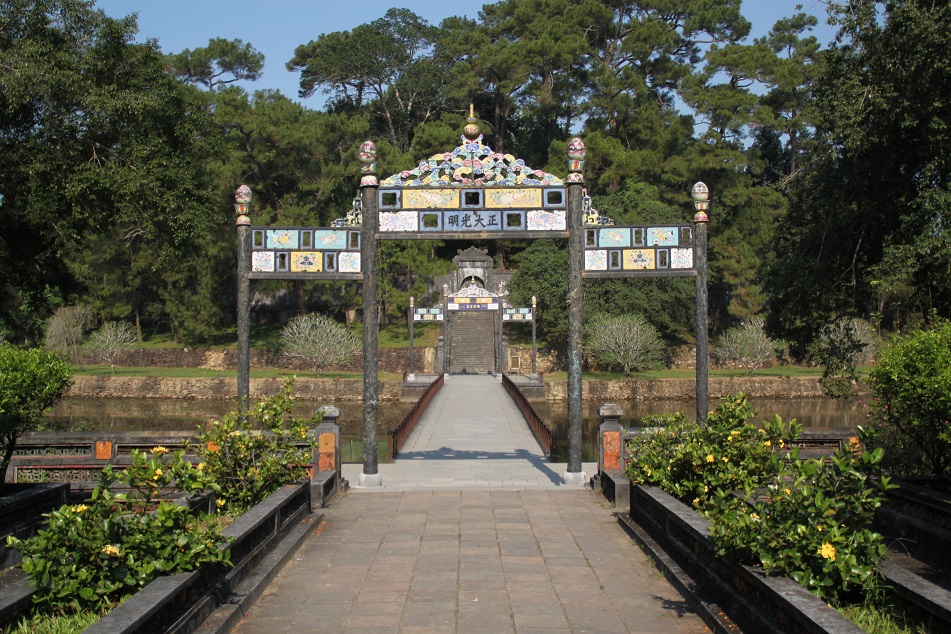




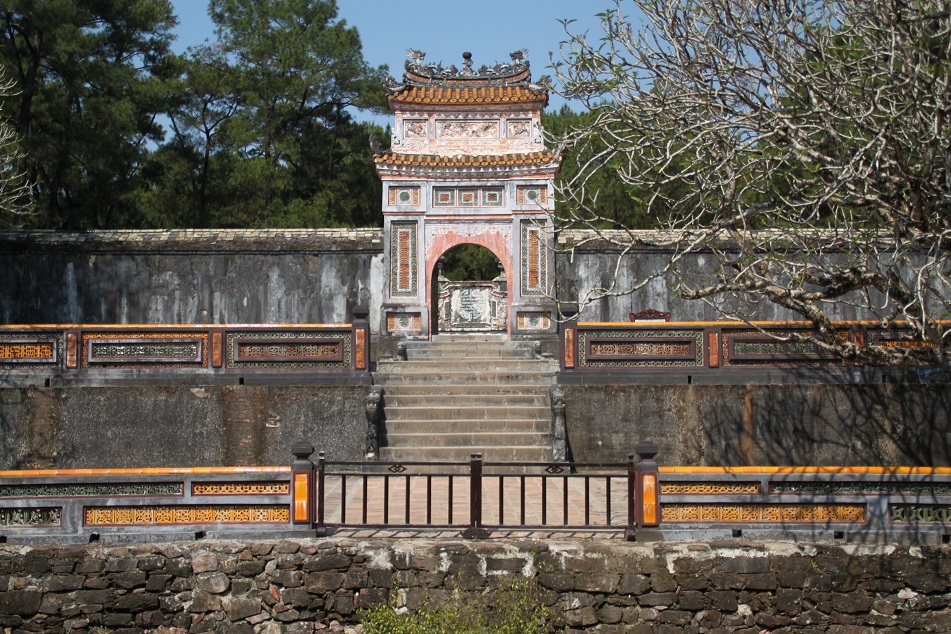

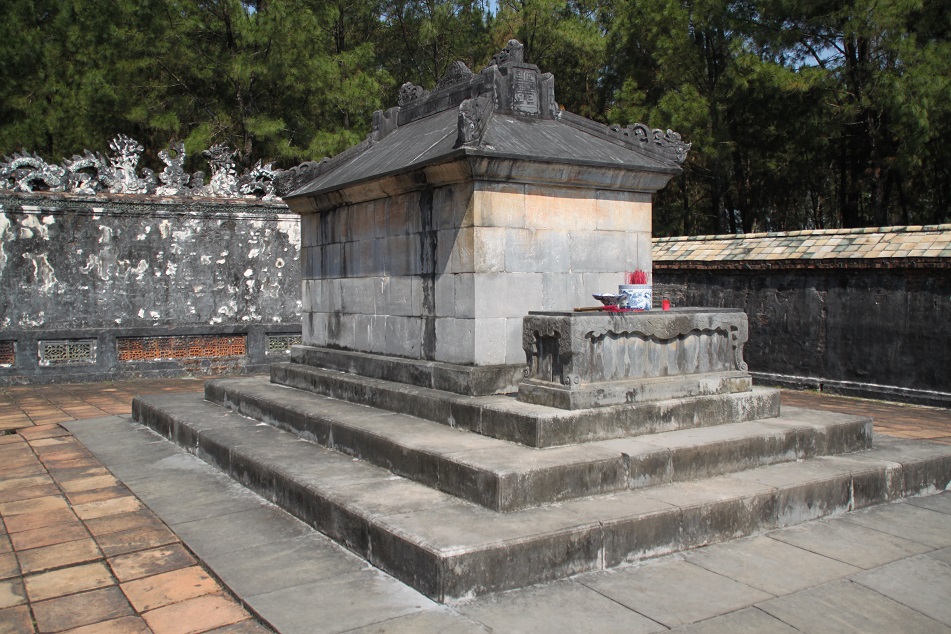
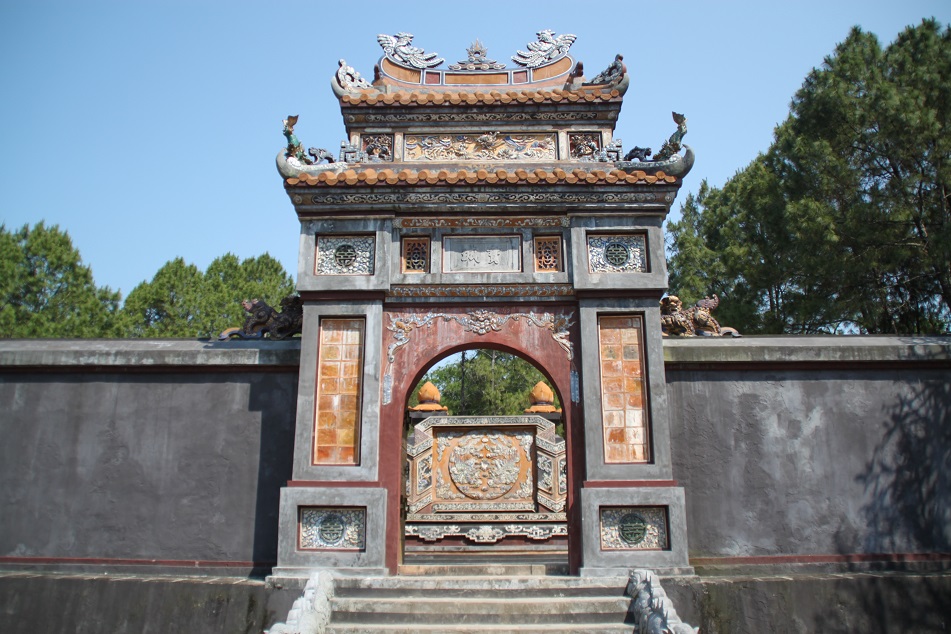

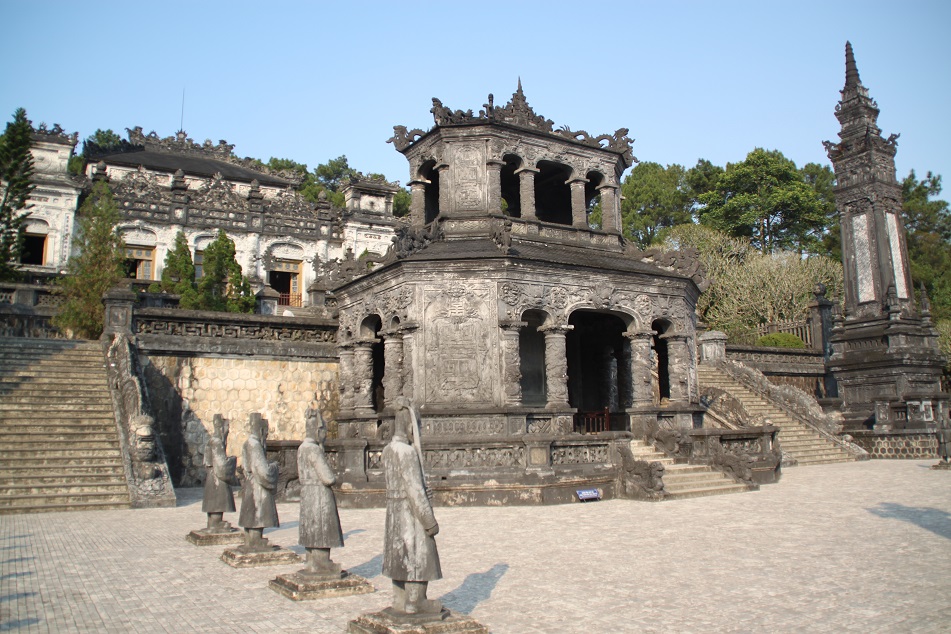

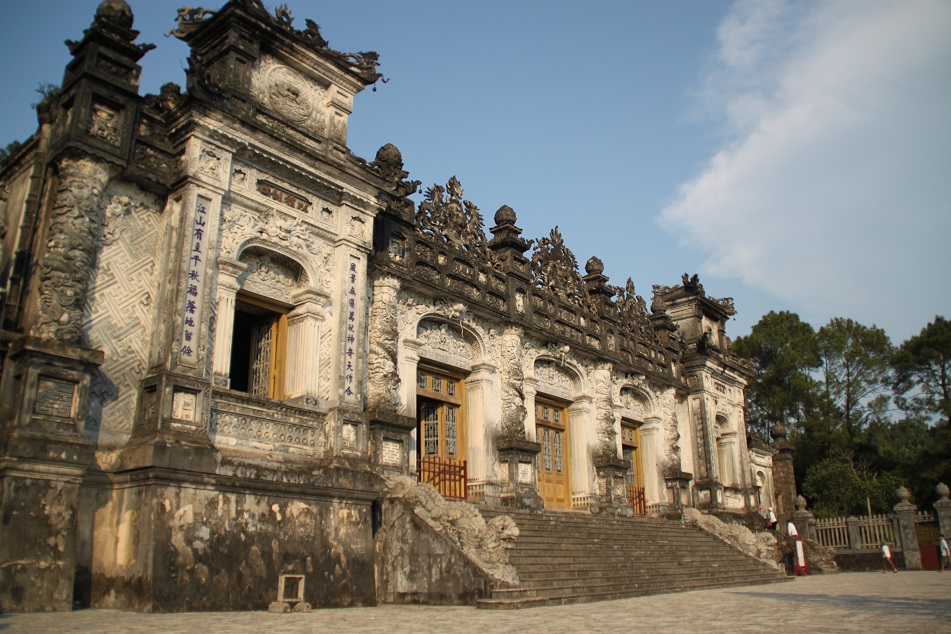


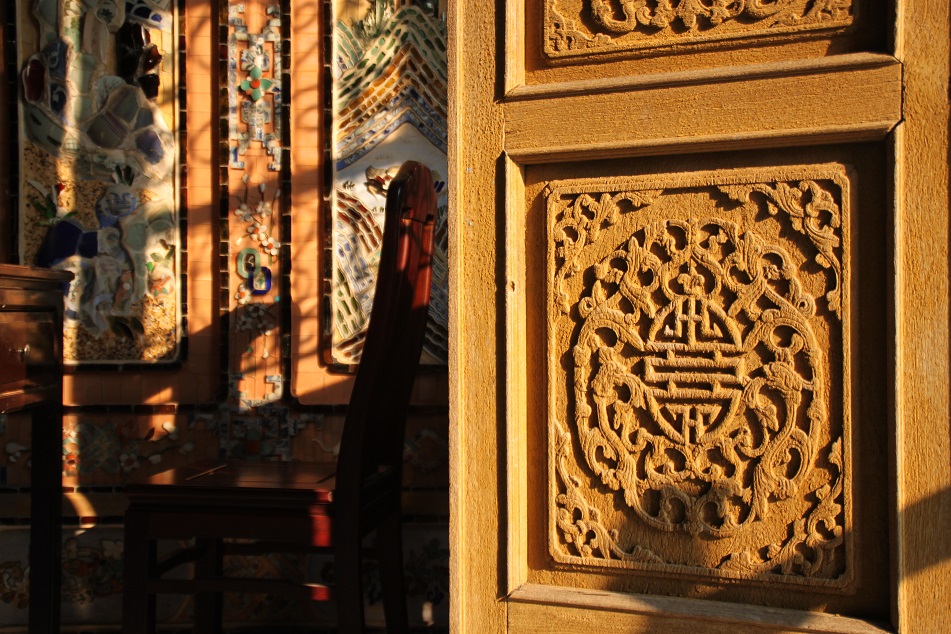
Hi Bama. Thanks for the informative post. Due to limited time in Hue, I had only visited Khai Dinh tomb. Without doubt his tomb is the most lavishly-decorated among the rest.
LikeLike
You’re welcome, Rizam, and thanks for readin! When it comes to grandeur, the tomb of Khai Dinh easily tops them all. But the layout of the tomb of Minh Mang is the most impressive among the three. Wish you’ll get another chance to visit Hue!
LikeLiked by 1 person
Reblogged this on ENLIGHTENMENT ANGELS.
LikeLike
What a magnificent place! It never ceases to amaze me how much history there is throughout Asia. It is utterly fascinating!
LikeLike
And that is part of the reason why I’ve been exploring this part of the world for the last nine years! I really should plan a trip to another continent.
LikeLiked by 1 person
Oh but you have so much to offer in Asia! I am going to have to wait and go when I have months of time. that won’t be for quite awhile though.
LikeLike
That’s true. But the same thing applies to me when it comes to traveling in the Americas. I need months to explore the places I want to see the most!
LikeLiked by 1 person
I can’t wait until I have time to really explore Asia. It will take months.
LikeLiked by 1 person
Fascinating post Bama, about a Vietnam that I did not know existed. We never got to Hue but I see we missed out on a lot of the history of the country. These three tombs and surrounds show me how it’s the same the whole world over – the rich and powerful create beautiful luxurious spaces, whether for in life or in death. I particularly love the lavish interior of Khai Dinh’s tomb.
Alison
LikeLike
Hue is one of those places steeped in history and culture so much so it’s impossible for anyone visiting it not feeling fascinated, intrigued and overwhelmed at the same time. From the Egyptian pyramids, to the Taj Mahal, and these opulent tombs in Hue, rulers all over the world really did (and still do) have a penchant for building great tombs. Khai Dinh’s tomb is undoubtedly the most lavishly decorated of them all. When you do come, make sure to visit in the afternoon for a nice ambiance. Thanks for reading, Alison!
LikeLiked by 1 person
Amazing post as always, Bama! I love the last photo. There is something nostalgic about it. I also want to add a minor detail, the name of the priest that create the modern-day Vietnamese is Alexander de Rhodes. Some argue that he should not be remembered (there is a small street in Saigon named after him) because he is partly responsible for the disappearance of traditional Vietnamese (a symbolic system like Chinese). But the past is the past and without him, I would have a hard time learning English and German 🙂
LikeLike
Thanks for the additional information, Len! In many cases, history is a double-edged sword. Dutch colonialism in Indonesia had brought suffering to a lot of people. But modern Indonesia wouldn’t have existed had the Dutch never colonized us at the first place. The most important thing is how to make peace with the past in order to progress. Thanks for sharing your thoughts!
LikeLiked by 1 person
Wonderful photography. You have a great eye for capturing the light!
LikeLike
Thanks! Practice makes perfect. Although my photography skill is still far from perfect, seven years after getting my DSLR camera I learned one thing or two about how light works.
LikeLike
It fascinates me that after so many centuries humans still believe that the best way to rule themselves is by giving autonomy to a single person over them. Looking through your spectacular photos of the Hue Tombs, I noticed the architecture seemed reminiscent of Thai temple styles as well. This intrigued me, considering they were political rivals.
LikeLike
And even more fascinating (if not perplexing) is that humans also believe that it’s in their best interest to let the descendants of that person to rule them for generations. Southeast Asia has always been a place where foreign influences amalgamate and create new cultures that are unique to the region. Although I see more resemblance with Chinese temples and architectural elements, I’m not surprised that you see Thai influences in those tombs as well. Thanks for sharing your thoughts!
LikeLiked by 1 person
Mas Bamaaaaaa….
Aku jadi ingat semua tombs yang pernah aku datengin di Huế dan sampe sekarang belum sempat ditulis sangking inget sebelnya perjalanan Da Nang – Huế pp. 😀 😀 😀
Tetapi aku mlotot terpesona dan menikmati banget di Khai Dinh dan berlama-lama disana (sebenernya karena neduh karena hujan!) Tapi cantik banget yaa…
BTW Mas Bama kehujanan ga sih di Huế? Kan tingkat hujannya gede banget sepanjang tahun….
LikeLike
Wah Mbak Riyanti terbawa perasaan nih, hehehe.. 😀
Makamnya Khai Dinh memang terasa banget kesan megahnya sih. Mulai dari tangga yang tinggi untuk naik ke halaman pertama, sampai bangunan utama yang penuh hiasan relief, semuanya memang mempesona. Saya selama di Hue boro-boro kehujanan mbak. Yang ada panas menyengat banget serasa matahari ada sepuluh di atas kepala. Kata salah satu staf hotel di sana April memang musim kemarau di Hue sih.
LikeLike
Makam dan istana di Hue megah-megah ya untuk ukuran negara Asia Tenggara (tapi gak bisa dibandingin sama Thailand juga sih, yang blink blink nya gak karuan). Tapi dari semuanya, sepertinya milik Kaisar Khai Dinh yang paling mewah ya. Btw, mereka langsung dikubur atau dikremasi dulu Bam?
Btw, aku baru tau kalau ternyata keturunan Kaisar Minh Mang itu memiliki sistem penamaan yang cukup rumit, sehingga nama belakang bapak dan anak bisa beda, tergantung dari urutannya pada syair yang diciptakan sang kaisar. O iya, itu seperti di Bali gitu gak sih, kalau sudah habis harus balik lagi ke awal?
LikeLike
Dan pastinya gak bisa dibandingin sama piramida di Mesir, hehe. Aku sih belum pernah baca cara pemakaman kaisar Vietnam itu dikubur atau dikremasi, tapi barusan searching menurut salah satu sumber Kaisar Tu Duc dulu dimakamkan, tapi bukan di lokasi yang sekarang. Ini menarik sih untuk digali lebih lanjut.
Aku baru tau soal sistem penamaan keturunan Kaisar Minh Mang itu ya pas baca postingan si blogger Amerika keturunan Vietnam itu. Kalau dia hidup di Indonesia pasti gak masalah tuh untuk melanjutkan tradisi penamaan itu. Tapi berhubung dia tinggal di Amerika, dimana sistem kependudukannya rapi dan sistematis, sepertinya dia bakal mengakhiri tradisi turun-temurun ini. Yang di Bali maksudnya untuk penamaan anak pertama, kedua, ketiga, dan keempat itu ya? Aku gak tau persis yang di Vietnam ini apakah bakal balik lagi ke awal atau enggak. Mungkin tergantung masing-masing keturunan sang kaisar sih ya, tergantung perkembangan zaman.
LikeLiked by 1 person
As Nicole alluded to I can’t even begin to imagine all of the history in Asia. I think it is wonderful that you have done such in depth visiting and learning. Beautiful post Bama.
LikeLike
There are still a lot of countries in Asia that I want to explore, but I wonder if it’s about time for me to travel beyond the continent. We’ll see where the wind takes me. Thanks Sue!
LikeLiked by 1 person
Of course we hope the wind brings you to North America. You are always welcome here.
LikeLike
Aww, thanks again for that, Sue. One day when I have ample time, I will surely consider visiting Canada!
LikeLiked by 1 person
Bama, these splendid tombs almost rival those in Egypt. Had never imagined anything like this in Vietnam. I love the weathered colours and the stylised elephant guardian. And the mandarins! Thank you for taking us on yet another outstanding virtual journey. One more for my bucket-list. At this rate my Indonesian trip will turn into an odyssey! 🙂
LikeLike
Prior to planning the trip to Vietnam, I knew there were several royal tombs around Hue. But I was still impressed to see the scale of those tombs when I saw them with my own eyes. When you visit Vietnam one day, you really shouldn’t miss Hue, Madhu! Ha, well, a few days ago I was making a list of places in Indonesia I have never been and would love to go at least once in the future. It ended up becoming a really long list! 🙂
LikeLike
Bama, I love how you interwove the photos from three very different royal tombs with an insightful look into Vietnamese history and the attitudes/actions of the Nguyen emperors. Architecturally my favorite was Khai Dinh because it’s such an unusual meld of East and West and it has a fanciful quality when it comes to the carvings/sculptures and decorations.
LikeLike
Thanks James! Khai Dinh tomb’s location on a hill made the approach really dramatic, and I agree that it has the most beautiful ornamentation of all the royal tombs we visited. I wonder how the other tombs look like, though. Maybe one day!
LikeLiked by 1 person
Such breathtaking photos. Well done!
LikeLike
Thanks Wendy! Glad your enjoyed the images on this blog post.
LikeLike
Wow! This place seems so spectacular and haunting, Bama. Do I need a guided tour for there?
LikeLike
Hue Citadel is quite a vast compound, but you don’t necessarily need a guide to explore it. However, I can imagine having one to explain the history of the entire complex can provide you with an interesting perspective of this site.
LikeLike
Pingback: Hoi An: A Revived Old Beauty | What an Amazing World!
Pingback: Jordan and A Travel Resolution Fulfilled | What an Amazing World!